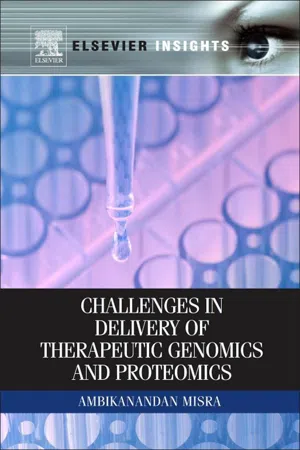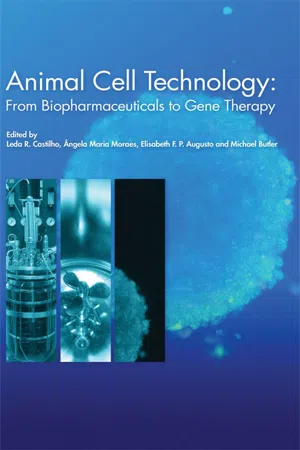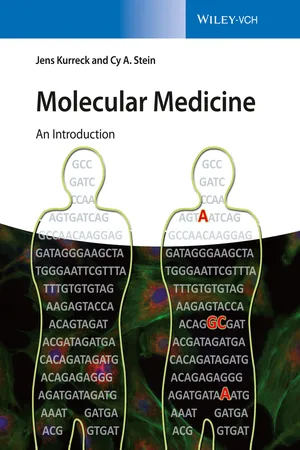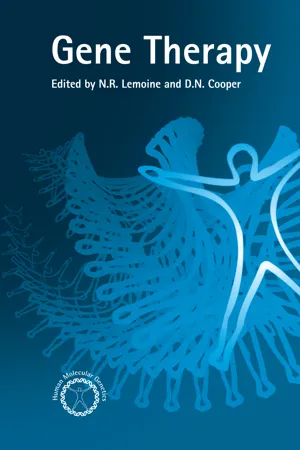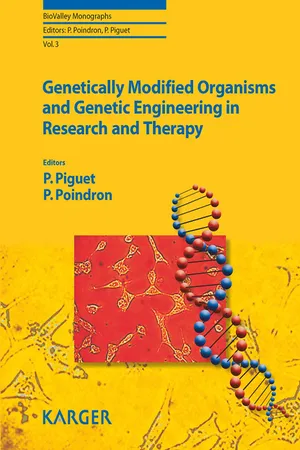Chemistry
Gene Therapy Process
Gene therapy is a process that involves introducing genetic material into a patient's cells to treat or prevent disease. This can be achieved by using viral vectors or other delivery methods to transfer the therapeutic genes into the target cells. The goal is to correct genetic mutations or provide new functions to the cells, offering potential treatments for various genetic disorders.
Written by Perlego with AI-assistance
Related key terms
12 Key excerpts on "Gene Therapy Process"
- eBook - ePub
- Tiago G. Fernandes, M. Margardia Diogo, Joaquim M.S. Cabral(Authors)
- 2019(Publication Date)
- Academic Press(Publisher)
More recently, methods of gene introduction, regulation, and editing have been the focus of promising therapeutic mechanisms in biomedical and pharmacological research endeavors. The formal definition of gene therapy, as defined by the National Institutes of Health (NIH), is the use of genes to treat or prevent disease [1]. Gene therapy can take many forms, such as replacing a mutated gene with a healthy copy, inactivating a mutated gene, or introducing a new gene into the body to help fight disease [1]. Gene therapies introduce foreign nucleic acid sequences to cells, which then can interact with the cell’s transcriptional and translational machinery to produce delivered nucleic acids or proteins. Due to the broad spectrum of potential disease targets and the ever-growing libraries of modular genes cassettes documented, gene therapies have been continuously investigated for treatment applications for decades. Historically, the first gene therapy clinical trial started in 1989, but early devastating complications regarding the safety of gene therapies slowed progress in the field [2]. These past failures motivated the need for better gene therapy designs for clinical application [2]. Several factors were addressed, ranging from the design of vectors themselves to the methods of their delivery to control spatiotemporal presence of therapeutic gene cassettes in target cell populations [3]. After over 2500 clinical trials and almost 30 years, the first five gene therapies were approved by the Food and Drug Administration (FDA) between the years 2015 and 2019 [2]. Gene therapies present many features, such as localizing therapeutic levels of biomolecules, that make them desirable when compared to traditional systemic therapeutic options for tissue regeneration and disease treatment - Ambikanandan Misra(Author)
- 2010(Publication Date)
- Elsevier(Publisher)
Fig. 6.1 . Initially, the required desired gene (or DNA-containing gene) is complexed, compacted, and packaged into a suitable vector, either viral or nonviral, to form the DNA–vector system. This system or the DNA alone is introduced into the target cells, using a physical, chemical, or biological method, where it gets dissociated to release the DNA. The released DNA, with or without integrating to the host cell DNA, expresses itself to produce protein, using the host cell machinery; this is followed by the therapeutic effect.Figure 6.1 Simplified schematic diagram on the basis of gene therapy. First, the foreign genetic material to be delivered has to be packaged in a suitable vector. (A) Introduction of the vector containing therapeutic genetic material into the cell cytoplasm. (B) Transfer of therapeutic genetic material into the nucleus of the recipient cell, followed by integration to cellular DNA. (C) Expression of the foreign therapeutic gene, resulting in synthesis of the desired protein product.6.1.1 Approaches for Gene Therapy
Gene therapy is a relatively new technology that holds great promise for treating a myriad of diseases in a unique manner. In genetic diseases, delivering the functional gene can potentially cure the disease, which would be a significant improvement over lifelong protein replacement therapy or no therapy at all. For acquired diseases like cancer, gene therapy allows local production or cancer-cell targeted expression of a therapeutic gene product. Basically, there are four protocols or strategies that are used to achieve the goals of gene therapy.1. In vitro approach2. Ex vivo approach3. In situ approach4. In vivo approachThe in vitro approach utilizes reporter genes like pEGFP , β-gal in the cultured cells to evaluate the transfection efficiencies of a gene carrier system [4] . The ex vivo approach involves initial removal of the target cells from the body, which are then cultured in vitro and incubated with vector containing the gene to be delivered. The genetically altered cells are then reintroduced into the patient’s body. This approach is most frequently used for easily accessible body cells and tissues like epithelial cells, blood cells, muscle cells, stem cells, and so forth [5] . The in situ protocols utilize the direct injection of the DNA–vector system in close proximity of target cells in the body, for example, in aerosol administration of the cystic fibrosis (CF) gene-containing vector to the respiratory tract or direct injection of vectors in tumor mass. However, the in vivo protocols are utilized when the target site and site of administrations is different, that is, a remote target site in the body. In this approach, the tissue or cells require specific carriers (using targeting ligands or antibodies) to deliver the genes [5 ,6 ]. There are numbers of human diseases, both genetic and acquired, for which gene-based therapeutic approaches are gaining appraisals. Initially, gene therapy arose with the aim of treating genetic diseases like CF, hemophilia, and hypercholesterolemia. But as the base of gene therapy broadened, other human disorders with genetic alternations have also been tried for treatment like rheumatoid arthritis, various types of cancer, cardiovascular (CV) diseases, renal disorders, hepatic disorders, acquired immunodeficiency syndrome (AIDS), severe combined immunodeficiency (SCID) diseases, peripheral vascular diseases, some neurological conditions, and so forth. However, the majority of human clinical trials conducted to date are aimed at treating cancer. The various genetic and acquired disease targets for gene therapy are summarized in Table 6.1 [7]- eBook - ePub
Animal Cell Technology
From Biopharmaceuticals to Gene Therapy
- Leda Castilho, Angela Moraes, Elisabeth Augusto, Mike Butler(Authors)
- 2008(Publication Date)
- Taylor & Francis(Publisher)
With the advent of new knowledge in cell and molecular biology, it has become evident that the causes of many human diseases are related to changes in genes. Genes represent the starting point for all events that subsequently lead to changes in expression of proteins in cells. Protein function determines, in turn, the cell phenotype and cell function. When genes are changed in such a way that the proteins encoded by them are unable to perform their normal function, a genetic disorder may occur. The cumulative effect of events triggered by atypical or defective genes in an organ leads to the disease phenotype. Gene therapy is a technique used to correct genetic defects that may cause the development of diseases, and consists of blocking an undesirably activated gene, or correcting or replacing the defective gene with a normal gene (Figure 21.1). The diseases primarily targeted by human gene therapy are monogenic, that is, those caused by defects in a single gene (Anderson, 1998). Since the 1990s, the development of DNA vaccines has led to the concept of gene therapy being extended to prophylaxis and treatment of infectious diseases (Brun-nell and Morgan, 1998).The first step in gene therapy is to identify the gene causing the problem. Then the appropriate genetic material is introduced into the target cells, with the aim of correcting the problem. Two main strategies are used: (i) in vivo therapy, in which the genetic material is introduced directly into the individual by a systemic route, or when possible, at a specific site; (ii) ex vivo therapy, in which the target cells are treated withthe gene product outside the individual. The cells are expanded and then transferred back to the patient (Figure 21.2 ).Figure 21.1 In a normal cell, genes are transcribed into messenger RNA (mRNA), and thereafter, translated into proteins with specific functions (A). When the gene responsible for encoding a protein has a defect, this may cause the translation of a defective protein, unable to perform its function and leading to a disease (B). Gene therapy aims to rectify the defect, by blocking, correcting, or replacing the gene.The key to successful in vivo gene therapy is the transfer of the genetic material to the target cells or tissues and the effective expression of the gene in question. However, this is a complex process, requiring several barriers to be overcome. Ex vivo gene therapy involves the transfer of genes to cells maintained in culture and their subsequent transplantation to the target tissue. The cells to be transfected must be available in large amounts, have a long life after transfer to the host, express the gene of interest for a long time period, and not trigger any kind of immune response. The advantages of ex vivo therapy include the possibility of characterizing the modified cell population before transfer. This makes it easier to introduce the genetic material into the cells and it can be insured that the clonal population of cells expresses a high amount of the product encoded by the transgene before transfer back into the patient. - eBook - ePub
Methods and Applications of Statistics in Clinical Trials, Volume 1
Concepts, Principles, Trials, and Designs
- Narayanaswamy Balakrishnan, N. Balakrishnan(Authors)
- 2014(Publication Date)
- Wiley(Publisher)
Chapter 33 Gene Therapy Samantha L. Ginn and Ian E. Alexander 33.1 Introduction Gene therapy is defined by the United Kingdom’s Gene Therapy Advisory Committee as “the deliberate introduction of genetic material into human somatic cells for therapeutic, prophylactic or diagnostic purposes” [1] and was conceived, originally, as an approach for the treatment of inherited monogenic diseases. Ongoing improvements in gene-transfer technologies and biosafety have been accompanied by a growing appreciation of the broader scope of gene therapy. Pathophysiological processes such as wound healing [2, 3], chronic pain [4] and inflammation [5, 6], cancer [7–9], and acquired infections such as HIV-1 [10] are now becoming realistic targets for this promising therapeutic modality. The first authorised gene transfer study took place at the National Institutes of Health (NIH) in 1989. In this marker study, tumor-infiltrating lymphocytes were harvested, genetically tagged using a 7-retroviral vector, and reinfused with the intention of examining the tumor-homing capacity of these cells. This landmark study provided the first direct evidence that human cells could be genetically modified and returned to a patient without harm [11]. Since then, over 1800 trials have been approved, initiated, or completed worldwide [12], with the majority being in the United States [13, 14]. Most studies have focused on cancer, with monogenic and cardiovascular diseases the next most frequent indications (Table 1). These predominantly early-phase trials have provided invaluable proof-of-concept for gene therapy by confirming that desired changes to the target cell phenotype can be achieved successfully. In most trials, however, an insufficient number of cells have been genetically modified to achieve therapeutic benefit - eBook - ePub
Advances In Pharmaceutical Cell Therapy: Principles Of Cell-based Biopharmaceuticals
Principles of Cell-Based Biopharmaceuticals
- Christine Günther, Andrea Hauser, Ralf Huss(Authors)
- 2015(Publication Date)
- WSPC(Publisher)
Cell-Based Gene Therapy 14Sabine Geiger14.1Definition: What is Gene Therapy?
Gene therapy is the use of genetic material for therapeutic purposes. It is still mostly an investigational treatment that involves the introduction of recombinant nucleic acids into an individual’s cells to prevent, cure or alleviate disease. From the beginning, gene therapy had a rocky course, but due to breakthrough successes during the last few years, gene therapy is now on its way to progressing from an exploratory therapy to an approved treatment.Most commonly, DNA is introduced into cells or tissues by means of the so-called “vectors”. From the very early beginnings of gene therapy until now, the choice of vector was and still remains one of the most crucial points to consider when planning a gene therapy treatment. To date, viruses that are genetically modified to be safe for the patient are the most frequently used type of vector in gene therapy clinical trials worldwide. - eBook - ePub
Molecular Medicine
An Introduction
- Jens Kurreck, Cy Aaron Stein(Authors)
- 2015(Publication Date)
- Wiley-Blackwell(Publisher)
However, advances in vector technology are likely to overcome these obstacles in the near future. The term gene therapy refers to the transfer of genetic material into the cells of an individual's body with the intention of treating a disease. Classically, the affected patient carries a defective gene, the cause of the disease. The methods of molecular biology can be used to transfer the functional form of the gene to hopefully correct the defect (Figure 11.1). Examples of gene therapy include correction of metabolic functions, the replacement of missing blood coagulation factors, or the transfer of tumor suppressor genes for the treatment of cancer. In addition, gene therapy can be used to create cells with novel properties. For example, the body's own defense mechanisms against tumor cells can be triggered by the use of genes encoding cytokines. Genes for enzymes can be transferred, which convert the inactive precursor of a drug (prodrug) into the active form. DNA vaccination involves transferring viral genes, which trigger an immune response against the virus. Indeed, any transfer of nucleic acids designed to manipulate genes or to regulate gene expression may also be considered gene therapy. Examples also include antisense and RNA interference therapies, which will be addressed in Chapter 13. Fig. 11.1 Principles of gene therapy. Due to a defective gene, a protein may not be produced in the cells of the affected patient. With the aid of vectors, the intact version of the gene can be introduced into these cells. Whether or not the therapeutic gene is integrated into the genome of the host or remains episomal is determined by the choice of vector. The functional gene can then be expressed so that the active protein is synthesized and the defect corrected - K.V. Chaitanya(Author)
- 2022(Publication Date)
- CRC Press(Publisher)
Local modifications in the human genome are the objective of medicine since the role of a gene in inheritance has been established. Gene therapy is one way to improve the expression of a gene by altering its bases or by replacing the mutated nucleotides. Presently, gene therapy is one of the predominant areas of research globally in many laboratories, and most of its applications are at a practical level. Currently, gene therapy trials are being conducted in countries such as the United States of America, Europe, and Australia. The application of gene therapy to treat recessive genetic disorders such as cystic fibrosis, hemophilia, muscular dystrophy, sickle cell anemia, acquired diseases such as cancer, viral infections such as HIV is in progress. This chapter provides details regarding the methods employed for gene therapy, vectors, and ethical issues.6.2Gene Therapy and Genetic EngineeringA genetic disorder occurs due to the inheritance of a mutated gene, having harmful effects on an individual. Most genetic disorders are recessive, expressed in a small percentage of the population. Most of the population are carriers for one or more disorders. Specific genetic disorders are also recorded as higher in an ethnic group. The inheritance of genetic disorders in humans occurs due to improper functioning of a specific gene, change in its sequence, or addition or deletion of nucleotides. The essence of gene therapy is in replacing a defective gene with a healthy one to solve the problem. Patients have received genetically engineered cells as treatments for genetic disorders such as hemophilia and sickle-cell anemia. Currently, genetic engineering of cells from bone marrow for enhancing the immune cells’ ability to fight against cancer and resist the infection of viruses such as HIV is practiced. A similar approach may also lead to an effective treatment for hereditary disorders.6.2.1 Gene Therapy
Gene therapy is a process of gene insertion into the cells and tissues of an individual for the treatment of hereditary disorders. During this process, a deleterious mutated allele is replaced with a functional one. Even though this technology is still in its infancy, its application has achieved some success. Further, scientific progress has been continuing to move gene therapy towards mainstream medicine. The first clinical trial for human gene therapy was carried out in 1989 by Rosenberg and his team to treat severe combined immunodeficiency (SCID) by transferring the adenosine deaminase (ADA) gene into the T-Lymphocytes of a patient. Early success in clinical trials of gene therapy in SCID patients combined with efforts to improve transduction efficiency has provided an arena for the successful transplantation of the ADA gene with increased efficiency. Eventually, this has resulted in low dose conditioning with busulfan, used to engraft gene-modified cells during ADA-SCID setting. After this successful landmark study on SCID, over 1700 clinical trials have been pursued, various diseases and disorders have seen an average of 100 new gene therapy clinical trials since 1999.- eBook - ePub
The Future of Pharmaceuticals
A Nonlinear Analysis
- Sarfaraz K. Niazi(Author)
- 2022(Publication Date)
- CRC Press(Publisher)
Cancers. 2019;11:1265.11.2.5 Techniques
The key methods used to prevent or treat diseases in gene therapy include the following.- The insertion of genes entails injecting a new copy of a gene into the target cells to produce more protein. A mutated virus such as an adeno-associated virus (AAV) is most commonly used that brings the genome into the cells. Gene-added treatments are applied to many diseases, including extreme combination immunodeficiency adenosine deaminase (ADA-SCID), hemophilia, Leber’s congenital amaurosis, congenital blindness, lysosomal storage diseases, X-linked chronic granulomatous disease, and many more.
- Gene repair is accomplished by altering part of a gene using a recently developed gene-altering technique (e.g., CRISPR-Cas9, TALEN, or ZFN) to delete repetitive or abnormal gene elements or replace an impaired or faulty DNA region. Gene correction produces a protein that functions naturally to treat the disease. Gene repair is used to diagnose a wide variety of diseases; recent scientific research has used gene editing techniques to remove HIV from the genome of infected laboratory mice and eliminate from the human gene the enlarged area responsible for Huntington’s disease.
- Gene silencing stops a specific protein from being created by targeting messenger RNA (mRNA). The mRNA occurs in both human and animal cells in a single-stranded form, whereas viruses have double-stranded RNA. Human and animal cells identify and kill double-stranded RNA as being viral to prevent it from spreading. Genome silencing uses limited RNA sequences to bind to double-strand special sequences in the target mRNA. It allows mRNA degradation using the cellular machinery that kills viral RNA. Gene silencing is useful for treating disorders. There is an overproduction of protein; for example, in rheumatoid arthritis, the alpha tumor necrosis factor is abundant (TNF) in the joints. Cell silencing targets only the affected tissue to reduce the TNF alpha levels.
- eBook - ePub
- David Cooper, Prof Nick Lemoine(Authors)
- 2020(Publication Date)
- Garland Science(Publisher)
15Cancer gene therapy I: genetic intervention strategies
Lesley-Ann Martin and Nicholas R. Lemoine15.1 Introduction
The aim of current cancer treatments is to destroy as much of the malignancy as possible without damaging normal tissue. However, despite continuing advances in surgical techniques and improvements in radiotherapeutic and chemotherapeutic regimes, this often proves difficult when tumours are inaccessible or widely disseminated throughout the body (Sikora, 1993). The continuing characterization of genes contributing to the development of cancer presents an opportunity to utilize these genetic elements and their products as targets for the treatment and (in the long term) prevention of the disease. In this chapter, we review some of the gene therapy strategies that are being developed for the treatment of cancer together with a consideration of how genetic intervention could be used in the context of the hereditary predisposition syndromes.15.2 Somatic and germ-line therapy
Gene therapy can be defined as the introduction and expression of exogenous genetic material into human cells to provide therapeutic benefit (Lemoine, 1994). This can be achieved by correcting an existing abnormality or by providing the cells with a new function. At present, the permanent correction of an inherited genetic condition by gene transfer to germ cells cannot be contemplated (Gutierrez et al., 1992; Lemoine, 1994; Wivel and Walters, 1993).15.3 Prevention of hereditary predisposition syndromes
Prevention of cancer currently relies on epidemiological studies to identify factors involved in the aetiology of the disease and the subsequent modification of behavioural patterns of the general public. However, these studies require extensive research and the implementation of new health education measures, both of which can take decades to come to fruition (Gullick and Handyside, 1994). - P. Piguet, P. Poindron(Authors)
- 2012(Publication Date)
- S. Karger(Publisher)
Piguet P, Poindron P (eds): Genetically Modified Organisms and Genetic Engineering in Research and Therapy. BioValley Monogr. Basel, Karger, 2012, vol 3, pp 86–102 ______________________ Gene Therapy for Cancer Treatment – State of the Art Amor Hajri Institute of Biology III, University of Freiburg, Freiburg, Germany ______________________ Abstract During the last decades, significant advances have been made in the field of gene therapy for the identification of new therapeutic genes, the design of innovative vectors and different ways of targeting. Cancer gene therapy is not indicated in clinical practice yet. However, basic and clinical advances have been reported which indicate the swift evolution of this field which, without any doubt, will be part of future cancer therapies. Many of the past obstacles and barriers are being actively overcome now. We are hopeful that cancer gene therapy will continue to progress and ultimately take its place within the existing anticancer armamentarium. Copyright © 2012 S. Karger AG, Basel Advances in molecular medicine as well as completion of the human genome project have allowed the identification of numerous disease-causing genes. These led to a new therapeutic approach, i.e. gene therapy that uses genes as a medicine to treat, cure or even prevent disease and thereby improve the quality of life. Gene therapy includes the treatment of both genetically based and infectious diseases by introducing genetic materials which have therapeutic effects [ 1 - 3 ]. It was first conceived as a treatment for hereditary single-gene defects, but gene replacement or repair can bring permanent relief in a number of other disorders. Therefore, gene therapy is also being developed for (1) acquired diseases such as cancer, (2) cardiovascular diseases, or (3) neurodegenerative disorders including Alzheimer’s, Parkinson’s and Huntington’s diseases, and (4) infectious diseases- Eric Wickstrom, Eric Wickstrom(Authors)
- 2020(Publication Date)
- CRC Press(Publisher)
This new holistic attitude toward gene discovery encouraged further thinking about the relationship of gene structure to gene function. Clearer links could be conceptualized between the action of multiple genes and the maintenance of basic biological function at cellular and tissue levels; a new approach to examining dynamic biological functions such as growth, cellular differentiation, and organ development could also be envisioned. Involved pathologies such as cancer could be interpreted through the dysfunction of a set of interrelated gene sequences. Even new routes to therapeutic development could be suggested. In short, when one contemplated the DNA sequences of all the genes of an organism together, the whole was now greater than the sum of the parts.In the face of these new attitudes and perceptions, scientists groped for a term to fuse the descriptive elements of primary gene sequence information with the complex dynamics of the biological expression of this information. The term genomics emerged to express the integrated study of the DNA structure of a genome and the multi-tiered, gene-directed functions of a genome.III. THE TECHNOLOGIES OF GENETIC THERAPY
There are three basic technologies which form the foundation of modern genetic therapy: gene therapy, antisense technology, and genomics. Each of these technologies has evolved from a different branch of science, giving each technology a unique path toward therapeutic development. However, since the inception of each, there has been a steadily increasing interrelationship. The key historic events which have taken place to form and connect each of these technologies is considered below.III.A. Gene Therapy
The impetus, if not the format, for modern gene therapy is found in molecular biology with the isolation of the first eukaryotic genes in the 1970s. The dramatic entrance of eukaryotic genes onto the experimental stage prompted many scientists to supply new details to older conceptual experimental designs for the transfer of "healthy" genes into bodies of individuals with "defective" genes to effect the cures of a host of wellcharacterized hereditary genetic diseases.Despite an awareness of the possibility of gene therapy, however, several obstacles had to be overcome in inventive or new ways before the first clinical trial in gene therapy could actually be performed in 1990. The major obstacles confronting gene therapy included: 1) the need to develop a method to transfer and stably express human genes in vivo, 2) the need to provide an institutional structure for public acceptance and professional review of emerging clinical protocols, and 3) lack of financial support to accelerate the growth of research and clinical development once a technical and institutional platform for gene therapy had been established. Historical treatments of the development of gene therapy may be found in several reviews (Friedman, 1992; Friedman, 1993; Wolff et al.,- eBook - ePub
- Robert Lanza, Robert Langer, Joseph P. Vacanti(Authors)
- 2000(Publication Date)
- Academic Press(Publisher)
Part VIII Gene Therapy CHAPTER 30 GENE-BASED THERAPEUTICS Lee G. Fradkin, J. Dezz Ropp and John F. Warner INTRODUCTION Many inherited and acquired disease processes, characterized at the genetic level, are known to be due to protein deficiencies or defects. Potential gene-based therapeutic strategies can now be designed to address these diseases. The initial premise of gene therapy was to correct heritable genetic disorders through gene replacement. However, the true potential of gene-based therapies can now be viewed in a broader context of biologics delivery for applications involving cancer, vaccines, genetic and metabolic disorders, viral infections, as well as cardiovascular and other organ-based interventions. The basic goal of gene-based therapeutics is the safe and effective delivery of genes to the disease site with subsequent expression, under physiologic conditions, of a therapeutic protein. Biotechnology, in existence for approximately two decades, has traditionally focused on the production of therapeutic proteins. This industry was formed on the concept that synthetic (i.e., in vitro) manufacture of therapeutic proteins offers safety, control, and cost savings over isolation from natural sources. The diverse biologic activities provided by therapeutic proteins present great opportunities for the treatment of disease. Despite the immense advances in this field, the individual qualities of recombinant therapeutic proteins also present obstacles in their development, manufacture, and utilization. The concept of gene-based therapeutics arises from a desire to minimize the complexity presented by utilizing protein as the delivered therapeutic and to capitalize, instead, on the manufacture and delivery of a more generic molecule, namely, DNA encoding the therapeutic protein
Learn about this page
Index pages curate the most relevant extracts from our library of academic textbooks. They’ve been created using an in-house natural language model (NLM), each adding context and meaning to key research topics.

